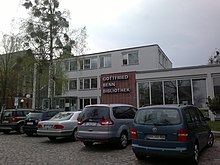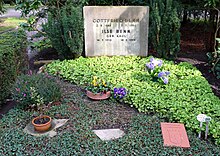Gottfried Benn
Gottfried Benn | |
|---|---|
 Gottfried Benn in 1934 | |
| Born | 2 May 1886 Mansfeld, Germany |
| Died | 7 July 1956 (aged 70) West Berlin, Germany |
Gottfried Benn (2 May 1886 – 7 July 1956) was a German poet, essayist, and physician. He was nominated for the Nobel Prize in Literature five times.[1] He was awarded the Georg Büchner Prize in 1951.
Biography and work
Family and beginnings
Gottfried Benn was born in a Lutheran country parsonage, a few hours from Berlin, the son and grandson of pastors in Mansfeld, now part of Putlitz in the district of Prignitz, Brandenburg.[2] He was educated in Sellin in the Neumark and Frankfurt an der Oder. To please his father, he studied theology at the University of Marburg and military medicine at the Kaiser Wilhelm Academy in Berlin.[3] After being laid off as a military doctor in 1912, Benn turned to pathology, where he dissected over 200 bodies between October 1912 and November 1913 in Berlin. Many of his literary works reflect on his time as a pathologist.
In the summer of 1912, Benn started a romantic relationship with the Jewish poet Else Lasker-Schüler.
Gottfried Benn began his literary career as a poet when he published a booklet titled Morgue and other Poems in 1912, containing expressionist poems dealing with physical decay of flesh, with blood, cancer, and death — for example No III — Cycle:
Der einsame Backzahn einer Dirne, / die unbekannt verstorben war, / trug eine Goldplombe. / Die übrigen waren wie auf stille Verabredung / ausgegangen. / Den schlug der Leichendiener sich heraus, / versetzte ihn und ging für tanzen. / Denn, sagte er, / nur Erde solle zur Erde werden.
— Gottfried Benn[4]
The solitary molar of a hooker, / who had died a missing person, / held a gold filling. / As if by silent agreement, the rest / had fallen out. / The mortician knocked out the filling, / pawned it and went dancing. / Because, he said, / only earth should return to earth.

Poems like this "were received by critics and public with shock, dismay, even revulsion."[7] In 1913 a second volume of poems came out, titled Sons. New Poems.[8]
Benn's poetry projects an introverted nihilism, that is, an existentialist outlook that views artistic expression as the only purposeful action. In his early poems Benn used his medical experience, often using medical terminology, to portray humanity morbidly as just another species of disease-ridden animal.[9]
World War I and Weimar Republic
After the outbreak of World War I he enlisted in 1914, and spent a brief period on the Belgian front, then served as a military doctor in Brussels. Benn attended the court-martial and execution of Nurse and British spy Edith Cavell. He also worked as a physician in an army brothel. After the war, he returned to Berlin and practiced as a dermatologist and venereal disease specialist.[10]
During the 1920s, he continued having a close relationship with Jewish poet Else Lasker-Schüler who addressed love poems to him. This bond to her is the subject of the film Mein Herz-niemandem (1997) by Helma Sanders-Brahms.
During the Third Reich
Hostile to the Weimar Republic, and rejecting Marxism and Americanism, Benn, like many Germans, was upset with ongoing economic and political instability, and sympathized for a short period with the Nazis as a revolutionary force. He hoped that National Socialism would exalt his aesthetics and that expressionism would become the official art of Germany, as Futurism had in Italy. Benn was elected to the poetry section of the Prussian Academy in 1932 and appointed head of that section in February 1933. In May, he defended the new regime in a radio broadcast, saying "the German workers are better off than ever before."[11] He later signed the Gelöbnis treuester Gefolgschaft, that is, the "vow of most faithful allegiance" to Adolf Hitler.[11]
The cultural policy of the new State didn't turn out the way he hoped, and in June Hans Friederich Blunck replaced Benn as head of the Academy's poetry section. Appalled by the Night of the Long Knives, Benn turned away from the Nazis. He lived quietly, refraining from public criticism of the Nazi Party, but wrote that the bad conditions of the system "gave me the latter punch" and stated in a letter that the developments presented a "dreadful tragedy!"[12] He decided to perform "the aristocratic form of emigration" and joined the Wehrmacht in 1935, where he found many officers sympathetic to his disapproval of the régime.[citation needed] In May 1936 the SS magazine Das Schwarze Korps attacked his expressionist and experimental poetry as degenerate, Jewish, and homosexual. In the summer of 1937, Wolfgang Willrich, a member of the SS, lampooned Benn in his book Säuberung des Kunsttempels; Heinrich Himmler, however, stepped in to reprimand Willrich and defended Benn on the grounds of his good record since 1933 (his earlier artistic output being irrelevant). In 1938 the Reichsschrifttumskammer (the National Socialist authors' association) banned Benn from further writing.
After the war
During World War II, Benn was posted to garrisons in eastern Germany where he wrote poems and essays. After the war, his work was banned by the Allies because of his initial support for Hitler. In 1951 he was awarded the Georg Büchner Prize. He died of cancer in West Berlin in 1956, and was buried in Waldfriedhof Dahlem, Berlin.

Reception
Benn had a great influence on German poetry immediately before World War I (as an expressionist), as well as after World War II (as the 'Static' poet).[13]
Books
- Morgue und andere Gedichte [Morgue and other Poems] (Berlin, 1912)
- Fleisch (1917)
- Die Gesammelten Schriften [The collected works] (Berlin, 1922)
- Schutt (1924)
- Betäubung (1925)
- Spaltung (1925)
- Nach dem Nihilismus (Berlin, 1932)
- Der Neue Staat und die Intellektuellen (1933)
- Kunst und Macht (1935)
- Ausgewählte Gedichte [Selected Poems] (May, 1936) Note: 1st edition contained two poems that were removed for the 2nd edition in November 1936: 'Mann und Frau gehen durch die Krebsbaracke' and 'D-Zug'. The vast majority of the 1st editions were collected and destroyed.
- Statische Gedichte [Static poems] (Zürich, 1948)
- Ptolemäer (Limes, 1949); Ptolemy's Disciple (edited, translated and with a preface by Simona Draghici), Plutarch Press, 2005, ISBN 978-0-943045-20-7 (pbk).
- Doppelleben (1950); autobiography translated as Double Life (edited, translated, and with a preface by Simona Draghici, Plutarch Press, 2002, ISBN 978-0-943045-19-1).
- Stimme hinter dem Vorhang; translated as The Voice Behind the Screen (translated with an introduction by Simona Draghici (Plutarch Press, 1996, ISBN 978-0-943045-10-8).
Collections
- Sämtliche Werke ("Stuttgarter Ausgabe"), ed. by Gerhard Schuster and Holger Hof, 7 volumes in 8 parts, (Stuttgart 1986–2003, ISBN 978-3-608-95313-8).
- Prose, Essays, Poems by Gottfried Benn, edited by Volkmar Sander; introduction by Reinhard Paul Becker (Continuum International Publishing Group, 1987, ISBN 978-0-8264-0310-0 & ISBN 978-0-8264-0311-7 (pbk.)
- Selected Poems (Clarendon German series) by Gottfried Benn (Oxford U.P., 1970, ISBN 978-0-19-832451-5)
- Gottfried Benn in Transition by Gottfried Benn, edited by Simona Draghici (Plutarch Press, 2003, ISBN 978-0-943045-21-4)
- Poems, 1937–1947 (Plutarch Press, 1991, ISBN 978-0-943045-06-1)
- Impromptus (Farrar, Straus and Giroux, 2013, ISBN 978-0-374-17537-5)
- Gottfried Benn – Friedrich Wilhelm Oelze: Briefwechsel 1932–1956, edited by Harald Steinhagen, Stephan Kraft and Holger Hof, 4 volumes, (Klett-Cotta/Wallstein, ISBN 978-3-8353-1826-7)
Notes
- ^ "Nomination Database". www.nobelprize.org. Retrieved 2017-04-19.
- ^ cf Primal Vision: Selected Poetry and Prose of Gottfried Benn edited by E. B. Ashton (NY: Bodley Head, 1961; Boyars, 1971; Marion Boyars, 1984, p. ix. ISBN 978-0-7145-2500-6
- ^ cf p. x.
- ^ Gottfried Benn: Morgue und andere Gedichte. 21. Flugblatt des Verlages A. R. Meyer, Berlin 1912./ Gottfried Benn: Sämtliche Werke ('Stuttgarter Ausgabe'), ed. by Gerhard Schuster and Holger Hof, 7 volumes in 8 parts, Stuttgart 2003 p. 12. ISBN 978-3-608-95313-8).
- ^ Translated and recited by Natias Neutert (with revisions added from the recent translation of David Paisey). Cf. Foolnotes, Booklet, Smith Gallery Performance, Soho New York 1980, p. 21.
- ^ Cf. Under the headline Latently existing words in the Frankfurter Rundschau, Anja Juhre-Wright talks with Natias Neutert about the difficulties of translating Benn. See external links
- ^ Reinhard Paul Becker: Introduction. In: Volkmar Sander (Ed.): Gottfried Benn. Prose, Essays, Poems. (Foreword by E.B. Ashton). The German L Vol. 73, Continuum, New York, p. XX*.
- ^ Gottfried Benn: Söhne. Neue Gedichte. Berlin (n.d. [1913].
- ^ Cf. Twentieth-Century Culture: A Biographical Companion edited by Alan Bullock and R. B. Woodings Harpercollins, 1984, p.61. ISBN 978-0-06-015248-2
- ^ cf E.B. Ashton (Ed.): Gottfried Benn Primal Vision. New Directions Publishing Corporation, New York, p. xi–xii.
- ^ a b 88 "writers", from Letters of Heinrich and Thomas Mann, 1900–1949, Volume 12 of Weimar and Now: German Cultural Criticism, University of California Press 1998 ISBN 978-0-520-07278-7, p. 367-8
- ^ Cf. Gottfried-Benn-Gesellschaft e.V. Freiburg im Breisgau, Germany: http://www.gottfriedbenn.de/lebenslauf.php
- ^ Derived from his most effective and well known work, from Gottfried Benn's Statische Gedichte. Arche Verlag, Zürich 1948/Limes Verlag Wiesbaden 1949 (with three more poems).
References
- German Dreams and German Dreamers: Gottfried Benn's German Universe by Henry Grosshans (Wyndham Hall Press, 1987, ISBN 978-1-55605-001-5 (pbk.).
- Gottfried Benn: The Unreconstructed Expressionist by J. M. Ritchie (London: Wolff, 1972, ISBN 978-0-85496-046-0.
- Beyond Nihilism: Gottfried Benn's Postmodernist Poetics by Susan Ray (Oxford; New York: P. Lang, 2003, ISBN 978-3-03910-006-4 & ISBN 978-0-8204-6275-2 (pbk.).
- Gottfried Benn's Static Poetry: Aesthetic and Intellectual-Historical Interpretations by Mark William Roche (University of North Carolina Press, 1991, ISBN 978-0-8078-8112-5.
- Primal Vision: Selected Poetry and Prose of Gottfried Benn edited by E. B. Ashton (NY: Bodley Head, 1961; Boyars, 1971; Marion Boyars, 1984, ISBN 978-0-7145-2500-6
- Twentieth-Century Culture: A Biographical Companion edited by Alan Bullock and R. B. Woodings (Harpercollins, 1984, ISBN 978-0-06-015248-2
- Gottfried Benn and his Critics: Major Interpretations 1912–1992 by Augustinus P. Dierick. [Columbia SC: Camden House Inc.], 1992.
- German Literature Under National Socialism by J. M. Ritchie (London: C. Helm; Barnes & Noble, 1983, ISBN 978-0-389-20418-3.
- The Appeal of Fascism: A Study of Intellectuals and Fascism, 1919–1945 by Alastair Hamilton, foreword by Stephen Spender (London: Blond, 1971, ISBN 978-0-218-51426-1.
- Biographical Dictionary of the Extreme Right Since 1890 by Philip Rees (New York: Simon & Schuster, 1990, ISBN 978-0-13-089301-7).
- Reason and Energy: Studies in German Literature by Michael Hamburger (London: Routledge & Paul, 1957; New York: Grove Press, 1957; London: Weidenfeld & Nicolson, 1970, revised ed., ISBN 978-0-297-00267-3.
- Encyclopedia of the Third Reich by Louis Leo Snyder (New York: McGraw-Hill, 1976, ISBN 978-0-07-059525-5; London: Blandford, 1989, ISBN 978-0-7137-2167-6; New York: Paragon House, 1989, 1st pbk. ed., ISBN 978-1-55778-144-4; New York: Marlowe, 1998, ISBN 978-1-56924-917-8
- Snow from Broken Eyes: Cocaine in the Lives and Works of Three Expressionist Poets, Richard Millington, (Peter Lang AG, 2012)
External links
- Works by Gottfried Benn at Project Gutenberg
- Works by or about Gottfried Benn at the Internet Archive
- Translation of Astern/Asters
- Gottfried Benn in the German National Library catalogue
- Gottfried Benn Society, German language site
- Latently existing words
- 1886 births
- 1956 deaths
- People from Prignitz
- People from the Province of Brandenburg
- Expressionist poets
- German Expressionist writers
- Writers from Brandenburg
- Georg Büchner Prize winners
- Modernist writers
- German military personnel of World War II
- Officers Crosses of the Order of Merit of the Federal Republic of Germany
- 20th-century German poets
- Recipients of the Iron Cross (1914), 2nd class
- University of Marburg alumni
- German male poets
- German male essayists
- German essayists
- Deaths from cancer in Germany
- German-language poets
- 20th-century essayists
- 20th-century German male writers
- Philosophical pessimists
- German military personnel of World War I
- Members of the German Academy for Language and Literature
